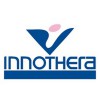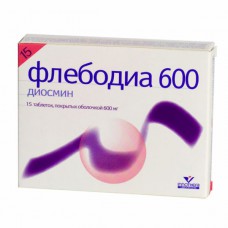Expiration date: 03/2026
Composition and form of issue:
Tablets, film-coated. 1 tablet contains:
granulated diosmin (corresponds to anhydrous purified) 600 mg
excipients: talc silica colloidal anhydrous stearic acid MKC protective film type Sepifilm 002 (hypromellose, MCC, polyethylene glycol 400 stearate) a mixture of dyes of the type Sepisperse AP5523 (propylene glycol, hypromellose, titanium dioxide, cochineal red (Ponceau 4R), iron oxide black, iron oxide red) Oppos 6000 (palm wax, beeswax, gummies, ethanol 95%) in the quantity necessary for 1 tablet, coated
in packing contour cell 15 PCs. in cardboard pack 1 or 2 packs.
Description of dosage form:
Round biconvex tablets, film-coated pink Matochkin — the core is greyish-brown.
Pharmacokinetics:
Rapidly absorbed from the gastrointestinal tract, found in plasma 2 hours after administration. Cmax in blood plasma is achieved after 5 h after administration. Evenly distributed and accumulated in all layers of the wall of hollow veins and subcutaneous veins of the lower extremities, to a lesser extent — in the kidneys, liver, lungs and other tissues. Selective accumulation of diosmin and / or its metabolites in the venous vessels reaches a maximum of 9 h after administration and persists for 96 h.Excreted in the urine — 79%, feces — 11%, bile — 2, 4%.
Description of pharmacological action:
The drug has a phlebotonic effect (reduces the extensibility of the veins, increases the tone of the veins-dose-dependent effect reduces venous stagnation), improves lymphatic drainage (increases the tone and frequency of reduction of lymph capillaries, increases their functional density, reduces lymphatic pressure), improves microcirculation (increases capillary resistance — dose-dependent effect reduces their permeability), reduces the adhesion of leukocytes to the venous wall and their migration to paravenous tissues, improves oxygen diffusion and perfusion in the skin tissue, has an anti-inflammatory effect. It enhances the vasoconstrictive effect of adrenaline, norepinephrine, blocks the production of free radicals, the synthesis of PG and thromboxane.
Indications:
- varicose veins of the lower extremities
- chronic lymphovenous insufficiency of the lower extremities
- hemorrhoids
- microcirculation disorders.
Contraindications:
- hypersensitivity to the drug components
- children (under 18 years).
Use during pregnancy and breast-feeding:
Until now, in clinical practice, there have been no reports of any side effects when using the drug in pregnant women. In experimental studies, there was no teratogenic effect on the fetus.
During breastfeeding, it is not recommended to take the drug, because there are no data on the penetration of the drug into breast milk.
Side effect:
In rare cases-hypersensitivity to the components of the drug (requiring a break in treatment).
From the gastrointestinal tract: dyspeptic disorders.
CNS: headache.
Drug interaction:
Clinically significant effects of interaction with other drugs are not described.
Dosage and administration:
Inside.
With varicose veins of the lower extremities and the initial stage of chronic lymphovenous insufficiency (heaviness in the legs) — 1 table. a day in the morning before Breakfast for 2 months in severe forms of chronic lymphovenous insufficiency (swelling, pain, cramps), treatment is continued for 3-4 months in the presence of trophic changes and ulcers, the course is extended to 6 months or more. The course is repeated after 2-3 months.
With exacerbation of hemorrhoids-2-3 table. per day during meals for 7 days, then if necessary, you can continue to 1 table. 1 time per day for 1-2 months.
In the treatment of chronic lymphovenous insufficiency during the II and III trimesters of pregnancy-1 table. 1 once a day the drug is canceled for 2-3 weeks before delivery.
If you miss one or more doses of the drug should continue in the usual dosage.
Overdose:
The symptoms of overdose are not described.
Special instruction:
Treatment of an acute attack of hemorrhoids is carried out in combination with other drugs, in the absence of a rapid clinical effect, it is necessary to conduct additional examination and adjust the therapy.
There is evidence of the possible effectiveness of the drug in the treatment of fetoplacental insufficiency, for the prevention of bleeding, arising from the use of intrauterine devices and in the period after phlebectomy.
Flebodia
(Diosmin)
- Brand: Innothera Laboratoires




